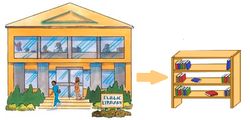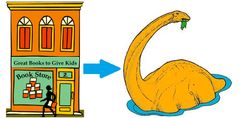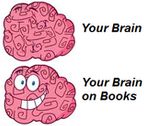Blogging & Musing...

In a previous blog post, we asked whether bookstores will go the way of dinosaurs? The question is even more pressing for libraries, which face a brave new digital world...on top of state and local budget cuts.
First things first: how will libraries adapt to the growing e-book age? That question plagues both libraries and publishers as the trend to digital books shoots upward. More and more of us are turning to Kindles, Nooks, and tablets—we find a book and download it NOW! It feels so good.
But what happens when you download an e-book from the library? Do you have to stand in a virtual line for two weeks till it's your turn to download their single copy? If that's the case, bye-bye library...it's a straight shot to Amazon!
Libraries don't own e-books the same way they own book-books. They license them from publishers through distributors. So...how many times are libraries allowed by publishers to lend the same e-book (simultaneously and over time)? Only once...20 times...100...1,000 times?
Fortunately, libraries and publishers are working on a business model that will sustain them both. They may settle on a subscription fee...or a flat fee per e-book, but whatever the ultimate solution, it should allow both to survive and thrive. At least in the near term.
The long-term is murkier: are bricks & mortar libraries even necessary? If books are virtual, existing in some amorphous computing cloud, will we need never-ending rows of bookshelves? If research is done by computers, what role will reference librarians play? We can deal with those questions in another blog post. But for now, let's say that very smart people are putting their heads together on this issue, too.
The final question—budget cuts. I've got a four-letter response to that...but it's unprintable.
Here's the four-word response—change our tax system.
If we're worried about dumbing down the American mind, something's very wrong with our priorities when we reduce library funding. The world may be turning digital, but for now—and for some time in the future—libraries serve as the communal repository of knowledge...available to all comers.
See the follow-up articles: Whither Go Libraries in the Digital Age—Part 2 and Part 3.
 Are local bookstores today's literary dinosaurs? A lot of people think so...and think Amazon has all but ensured their extinction
Are local bookstores today's literary dinosaurs? A lot of people think so...and think Amazon has all but ensured their extinction
Author Richard Russo unwittingly kicked off a kerfluffle by penning a NY Times op-ed piece. He, along with some big-ticket authors (Stephen King, Ann Patchett, and Anita Shreve and others), bemoaned the fate of brick & mortar stores. For Patchett bookstores represent "a critical part of our culture." Same with Tom Perrotta, who called them part of a "vital, real-life literary culture.” What's controversial about that?
Well, hold on: a couple of days later, online Slate magazine's Farhad Manjoo weighed in, calling Russo & company's argument "bogus." Pulling no punches, here's what he said:
Russo hangs his tirade on some of the least efficient, least user-friendly, and most mistakenly mythologized local establishments you can find: independent bookstores. Russo and his novelist friends take for granted that sustaining these cultish, moldering institutions is the only way to foster a “real-life literary culture,” as writer Tom Perrotta puts it.
Ouch! That hurts. Catch the words "least user-friendly" and "cultish, moldering institutions"—bookstores, for heaven's sake! But Manjoo makes an interesting case: because of online's low prices, ease of ordering, and instant access through digital readers, people are actually reading MORE. That's real-life literary culture, he says.
As far as preserving local community culture, here's what Manjoo has to say about that:
If you’re spending extra on books at your local indie, you’ve got less money to spend on everything else—including on authentically local cultural experiences...[your] local theater company...city’s museum...locally crafted furniture.... Each of these is a cultural experience that’s created in your community. Buying Steve Jobs at a store down the street isn’t.
My smart husband Pete says that Manjoo's own argument is bogus. It's not buying books that provides a cultural experience. Russo and others are referring to the store itself—a place to gather, real people to talk to, books to touch, chairs to sit on, a friendly storefront that graces a local street.
The issue won't go away; it resurfaced the other day on NPR (6 months after Russo's NY Times piece). The announcer interviewed Manjoo and a local bookstore owner, who sadly couldn't seem to address any of Manjoo's points. All of which allows to ME to pontificate...
Who's right or wrong? It doesn't matter. The fact is that local bookstores are bordering on extinction. It. Will. Happen...at some point. The younger generation was rasied on techno-pablum; they don't get all dewey eyed over books like we do. They get their news online...play games online...connect with friends online...look up words online.... They LIVE online. It's what they've grown up with.
Bye-bye bookstores. Will we miss them? You bet—big time! Will it alter our reading habits or our literary experience? Probably not. Still, it will be a different world, and we'll all have to adjust—I don't think we'll have a choice. Sigh....
 Some years ago, when her daughter entered the fourth grade, author Tracy Carbone* became part of a Mother Daughter Book Club. I asked Tracy to share some ideas with the rest of us on how to go about starting a club for moms and their girls. So...here's Tracy!
Some years ago, when her daughter entered the fourth grade, author Tracy Carbone* became part of a Mother Daughter Book Club. I asked Tracy to share some ideas with the rest of us on how to go about starting a club for moms and their girls. So...here's Tracy!
A beautiful, poignant story, Tracy. Thanks so much for sharing it. If anyone else has been part of a mother-daughter book club...let us hear from you.Mother Daughter Book Club
Tracy L. CarboneNine years ago Lisa, the mother of one of my daughter's friends, learned she had breast cancer. Fortunately, she survived. Two years later she decided she wanted to do something special—something to create lasting memories for her oldest daughter.
So Lisa made some calls to find out who would be interested in starting a Mother Daughter Book Club. Ten of us signed on—five mothers and five daughters—all of us excited to be in such an exclusive group.
One of the first things Lisa did was to create a binder, which we used month after month...year after year. In it were the names of each month’s book, along with the five discussion questions posed by the daughter who ran that month’s meeting. Whoever ran the meeting got to host the group and choose the book for the following month. Our first book was the beloved 1945 children's classic—The Hundred Dresses by Eleanor Estes.
By the end of the girls' fourth grade year, we had read one book a month, most of them tame and friendly. But one question kept popping up, time and again: as our girls read the books and studied the plots they always asked, “Why don’t the characters just tell their parents?” We moms wondered the same thing, and their question revealed to us just how strong our bonds were with our daughters—and how our club had become a place where they could trust us.
With each book, we mothers were reminded of our own childhoods, often sharing with the group and our daughters stories no one had heard before. By the end of nearly every meeting, there were tears of joy and remembering, and heaps of sharing.
The girls matured, moving into fifth, sixth and then seventh grades. When bras and periods came into play, we moved up to books like Are You There God? It’s Me Margaret (Judy Bloom, 1970). We also combined movies with books if possible, including Because of Winn Dixie (Kate DiCamillo, 2000) and The Last Song (Nicholas Sparks, 2009), as the girls grew older.
Sadly, midway through the girls' seventh grade, Lisa’s cancer returned with a vengeance. We stepped up the meetings, choosing riskier books, teaching our girls as much about love and heartbreak and reality as we could, preparing them for the road ahead in an environment—our club—where they could feel safe.
Books like So B. It (Sarah Weeks, 2004), Jars of Glass (Brad Barkley, 2008), Hope Was Here (Joan Bauer, 2000) and Call Me Hope (Gretchen Olson, 2007) filled our shelves. These were life-affirming stories that demonstrated tenacious female characters finding strength in what remained. We read Mother-Daughter Book Club (Heather Vogel Frederick, 2007) and set up a conference call with the author, while luxuriating in an oceanfront hotel in Maine.
The five girls grew very close because of this bond. Lisa lost the battle to cancer at the beginning of the girls’ eighth grade. Though the bookclub carried on the rest of the year, by high school, the girls’ workloads were heavy and extra reading wasn’t possible.
We had a good clip though. Five years of stories of courage and love and life. I wouldn’t trade those memories for anything.
* Tracy L. Carbone is author of The Soul Collector for young readers. Check out her book on Amazon (click on the book's cover image). Also, be sure to visit her website at Tracy L. Carbone's Writing Website.
 Now we know why we're hung up on reading. We talk about the guilty pleasures of the novel, of being sucked into a story, but it turns out we have an excuse. Lucky us—we're actually hard wired to respond to fiction.
Now we know why we're hung up on reading. We talk about the guilty pleasures of the novel, of being sucked into a story, but it turns out we have an excuse. Lucky us—we're actually hard wired to respond to fiction.
If a character in a book walks across a room to close a window, the brain's motor cortex—the part that directs our physical action—lights up. It's as if we, not the character, got up out of our chair to close the window. More suprising, the motor cortex region associated with leg movement and another with arm movement both light up.
But wait! There's more! When scents or textures are described, our brain's olfactory and sensory regions kick in. So "her skin was smooth as silk" elicits a more powerful brain response than "she had lovely skin." High-five for metaphors.
We've long intuited that literature allows us to transcend our own skin (speaking of skin) and experience, from the inside out, how someone else views the world. And guess what...brain studies confirm it.
It turns out people who read are more empathetic, with a higher proclivity for understanding different viewpoints. This cause-and-effect relationship holds true even when taking into account that people who empathize might be more inclined to read than those who don't.
Be sure to read the fascinating article by Annie Murphy Paul: New York Times, March 12, 2012. It's good reading...will light up your brain!

Overheard at a party:
"What do you do?" he asks.
"I'm a writer," she says.
"Would I have heard of you?"
So she tells him her name.
No recognition.
"I write about families, marriage, sex, and desire," she adds.
"Oh, wait,"he says. "Lemme get my wife—SHE READS THOSE KIND OF BOOKS."
True story as told by author Meg Wolitzer in a NY Times Book Review essay. Wolitzer is a fine author with a string of highly regarded books to her name.
Her beef isn't that the man didn't know her name (she's not a celebrity writer) it's that he's a stand-in for most male readers, who don't value novels about marriage and family.
But then neither do the literati, Wolitzer argues, who typically ignore "relationship books"—unless those books are written by men.
She points to the shower of FAME & ACCLAIM poured down on Jeffrey Eugenides for The Marriage Plot and Jonathan Franzen for both Corrections and Freedom—all books centered around love, marriage, and family. The two authors romp in the same territory as female authors, but they get all the kudos.
Remember the dust-up between Oprah and Jonathan Franzen? In 2001 Oprah selected Corrections as one of her book club picks, but Franzen demurred… with an unfortunate comment: if his book became An Oprah Selection, no man—NO MAN!!!—would touch it. Oprah withdrew her Seal of Approval (only to bestow it 10 years later for Franzen's 2011 novel, Freedom).
I've written about this subject before, and shame on me. I was TIRED of all those intimate portraits of troubled families—you're always waiting for the next SHOE TO DROP… then the next… and the next …and eveyone's miserable …all the time. Men seem to use a larger canvas, resulting in books with more heft.
I feel like a traitor to my sex… especially because Meg Wolitizer reminded us of female authors who explore some daring territory:
—Jennifer Egan (A Visit by the Goon Squad)
—Karen Russell (Swamplandia!)
—Tea Obreht (The Tiger's Wife). Let's also add…
—A.S. Byatt (everything)
—Hilary Mantel (Wolf Hall and Bring Up the Bodies)
—Anne Patchett (State of Wonder)
—Zadie Smith (White Teeth)… And all that's just for starters.
Anyway, do read Meg Wolitizer's piece. It's thought provoking—with lots to talk about for any book group, especially a co-ed club.
 Imagine this: you're staying at a swank hotel in New York City, you're drinking and dining and hobnobbing with literary luminaries, and you receive a giftbag...like the ones handed out at kiddie birthday parties. Only not like them.
Imagine this: you're staying at a swank hotel in New York City, you're drinking and dining and hobnobbing with literary luminaries, and you receive a giftbag...like the ones handed out at kiddie birthday parties. Only not like them.
Your giftbag contains 12 books...delivered to your hotel room...and selected by a Pulitizer Prize winning author. For you. All for you. Oh! Happy daze, happy daze!
Such is the fate of the Poor Unfortunates who participated in the PEN Festival of International Literature starting April 30, 2012. The reigning Pulitzer winner, by the way, is still Jennifer Egan for A Visit from the Goon Squad. She was invited to select the books for the giftbag—here's what she chose...and why:
Emma by Jane Austen
Politics masquerading as matrimony. Austen was a mathematician of social interaction, and her novels are impossibly, preposterously good. Emma happens to be my favorite.
The Image by Daniel J. Boorstin
In 1961, before the Vietnam War was close to being televised, Boorstin identified...a longing for authenticity that naturally results from increased mediation of human experience. His observations hold eerily true even in the era of Facebook and YouTube.
Don Juan by Lord Byron
Who can resist an epic poem in which the protagonist gets shipwrecked, hides in a harem (and then is chosen by the sultan for an evening of pleasure), has a fling with Catherine the Great, and endless other romps—all narrated in Byron's slouchy, sinuous poetry?
Underworld by Don Delillo
My favorite American novel of the past 25 years. A gigantic vision of the Cold War and its aftermath, in which DeLillo manages to be sweeping, intimate, political, hilarious, and sad.
Middlemarch by George Elliot
A quintessentially swaggering 19-century English novel, thrillingly attentive to a sweep of diverse characters, and impossible to put down.
Invisible Man by Ralph Ellison
A surreal tale that exposes the ravages of racial persecution, yet ultimately subsumes them in a meditation on identity and transformation, whose proportions are nothing short of mythic.
The Transit of Venus by Shirley Hazzard
Utterly unique: a flexible, sharply written, wide-ranging story that encompasses the life of a young Australian woman who comes to England.
The Golden Notebook by Dorris Lessing
An epic, experimental yet utterly human work that manages to fuse a political vision (disillusionment with communism) with a social one (women, men, and the collisions between them).
Good Morning, Midnight by Jean Rhys
Tough, bleak, and deeply atmospheric. Rhys wrests a gripping--even phantasmagoric--narrative from the solitary perambulations of an alcoholic woman in Pais.
Tristam Shandy by Laurence Sterne
One of the first novels in English...and a bouyant, postmodern romp. A heart reminder of the power,malleability, and deep playfulness of the novel form.
The House of Mirth by Edith Wharton
Tragic in the classical sense, yet also hilarious, nuanced, and socially astute; the novel's cool assessment of the calculus of beauty and wealth rings true even in our radically divverent era.
Germinal by Emile Zola
My favorite reportorial 19th-century novel. A vivid story full of spectacular set pieces--like a horse being lowered into a coal mine--and also a brutal indictment of the mining industry's exploitation of its workers.
Thanks to The Daily Beast. And thanks, to my dear librarian, Lynne Schneider, at the Sewickley Public Library, for handing me the printout.
Quite a list. If you've not read them all...well, most of us haven't. They don't spring easily to mind...nor to the top of everyone's reading list. But HERE's THE QUESTION: what would you choose to be in the giftbag?
 The best Christmas stories ever, these are certainly my favorites. Count on them earning a place in your heart—and hopefully on your shelves so you can turn to them Christmas after Christmas. While most are sold as books for children, each invokes the magic of the season, no matter what age. They're for young and old alike.
The best Christmas stories ever, these are certainly my favorites. Count on them earning a place in your heart—and hopefully on your shelves so you can turn to them Christmas after Christmas. While most are sold as books for children, each invokes the magic of the season, no matter what age. They're for young and old alike.
10 Best Christmas Reads1. The Bible, Luke 1: 26-2:40 — King James, 1611
This choice should go without saying, of course: the very first Christmas story with all the majesty of the King James Bible, the most poetic of all Bibles. Handel surely thought so. Read Luke on Christmas Eve and listen to The Messiah.
2. The Best Christmas Pageant Ever — Barbara Robinson, 1972
The worst kids in the whole world take over the church Christmas pageant—to everyone's horror. But they end up—to everyone's amazement—revealing deeper truths about the very first Christmas. This story is so beloved that publishers have issued a picture book, two teacher guides and a play script. There's even a 1983 TV movie version. But read the book...of course! Delightful, laugh-out-loud shenanigans for kids and adults. (Paperback, 128 pp.)
3. A Christmas Carol — Charles Dickens, 1843; illustrated by P.J. Lynch, 2006
Almost everyone knows the tale of the original Scrooge and his awakening to the true spirit of Christmas. But this version of Dickens' classic is stunning—a real standout. P.J. Lynch's soft palate enhances the text with hauntingly beautiful illustrations. Do spring for the hardcover edition—it's a treasure, a book to keep forever. (Hardcover, 160pp., 9.3 x 7.8 x 1 inches.)
4. A Christmas Memory — Truman Capote, 1956
Capote's endearing account of his growing up years in rural Alabama and one Christmas spent with a favorite 60-ish spinster cousin. The two share adventures as they prepare an honest-to-goodness "handmade" Christmas in the midst of the Depression's scarcity. Use the ISBN number below to find the 1996 hardcover, Modern Library edition, which contains two other fine holiday stories. It's a wonderful, wonderful book. (ISBN: 9780679602378)
5. Letters from Father Christmas — J.R.R. Tolkien, 1976 (1st publication)
From 1920 through 1943, Tolkien "mailed" his children handwritten letters from Father Christmas recounting Santa's adventures and misadventures in the North Pole. This 2004 version, in addition to the full printed text, features Tolkien's own illustrations, as well as reprints of the letters and envelopes in his playful, wispy script. The envelopes are affixed with a hand-drawn Polar stamp. Exquisite to behold and magical to read. (Paperback, 111 pp., 9,7 x 7.5 x 0.3 inches.)
6. The Night Before Christmas — Clement J. Moore, 1823
How could we even get through the holiday without Dasher and Dancer and Prancer and Vixen? Here are my two favorite versions, each enhanced by a top children's illustrator:
- Charles Santore, 2011—rich, sumptuous, and traditional—with a stunning 4-page center fold-out that will catch your breath. A gorgeous edition.
- Bruce Whatley, 1994—vibrant and quirky, with illustrations that jump off the page. The father-narrator is this version's central character as he rediscovers a part of his childhood. Yet it's the reindeer with their wide-eyed abandon steal who the show (Cover and Amazn link, right).
(All hardcover; average size: 44 pp., 12 x 10.5 x 0.5 inches.)
7. The Polar Express — Chris Van Allsburg, 1985
For its sheer imagination and the luxurious quality of its illustrations, Polar Express became a Christmas classic the instant it hit the bookstores. Yes, there's a movie, but get the book instead—about a young boy who takes a magical ride to the North Pole. Gorgeous, simply gorgeous. Although meant as a young children's picture book, adults will find it hard to put down. (Hardcover, 32 pp., 9.2 x 11.5 x 0.5 inches.)
8. Stopping by Woods on a Snowy Evening — Robert Frost, 1956; illustrated by Susan Jeffers, 1978
Though Frost didn't write "Stopping by Woods" as a holiday poem, this lavishly illustrated version of his beloved classic evokes the warmth of the season while managing to maintain (for the most part) the original's eery, haunting quality. Purists may object to its semi-sweet tone, but it's a beautiful introduction to Frost—a slender book to be read over and over, suitable for adults and children. (Hardcover, 32 pp.; 8.6 x 7.3 x 0.4 inches.)
9. The Stupidest Angel — Christopher Moore, 2004
If you've tired of all the sentimentality and need a bracing dash of irreverence, here's the most irreverent Christmas book around—an angel in search of a miracle and a young boy who's sure he's witnessed someone offing Santa. You've got to love Moore to appreciate his wacky humor, off-color language, and off-beat characters. Christmas mayhem—silly at times, even sophomoric, often hilarious, and always fun. This one is not for kids. (Paperback, 320 pp.)
10. Twelve Days of Christmas — Illustrated by Jan Brett, 1997
This illustrated version of the 18th-century English Christmas carol should be in your hands—now! Jan Brett's illustrations are so whimsical, colorful and rich in detail you'll find yourself transported to another world—a world of pure, sumptuous delight. There's also a miniature 6 x 5-inch version, but go for the standard. Why skimp on something so lovely? (Hardcover, 32 pp., 10 x 8 x 0.2 inches.)
I've left out a lot of good ones, many of them novels (John Grisham's Skipping Christmas, Jason Wright's Christmas Jars). I've also omitted Jean Shepherd's Christmas Story, which is actually a novelization of separate stories, not all holiday oriented, that were collated for the film. I've not read the "book," but I love the movie.
For me, though, the real magic of Christmas is found in stories that appeal to children, as well as adults...ones to be read again and again. That, I think, explains most of my choices.
We'd love to hear about your favorites. Let us know on our Facebook page which Christmas stories you love.
Site by BOOM
![]()
LitLovers © 2024










